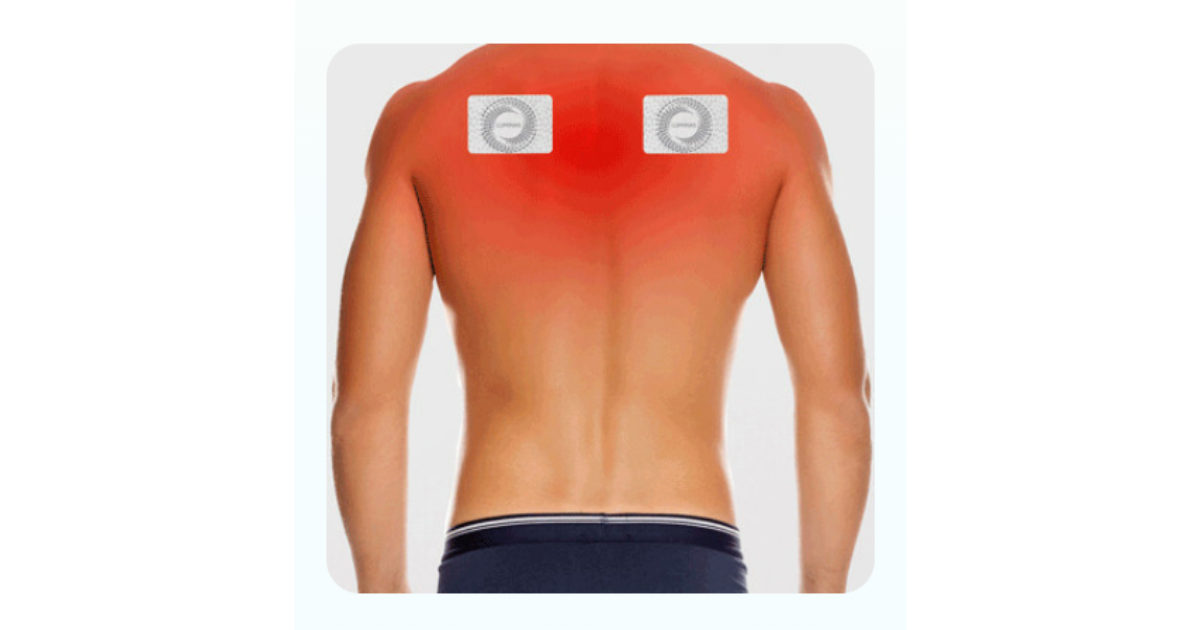5 Ways To Stop The Pain Between Your Shoulder Blades
Key Takeaways:
- Early Attention is Key: Ignoring shoulder blade pain can lead to chronic issues, so it’s important to address discomfort early.
- Common Causes: Muscle strain, acute injuries, sedentary lifestyles, poor posture, and underlying medical conditions like arthritis or heart issues are common causes of shoulder blade pain.
- Immediate Relief Options: Short-term solutions like alternating ice and heat, at-home massages, rest, and using pain relief patches can provide quick relief.
- LUMINAS Pain Relief Patches: Offer a safe, non-invasive solution for targeted, long-lasting relief, ideal for both short and long-term management.
- Exercise is Essential: Incorporating shoulder and upper back strengthening exercises, along with dynamic warm-ups, can prevent future discomfort.
- When to Seek Help: If pain persists or is accompanied by more serious symptoms like chest pain or difficulty breathing, seek medical attention immediately.
We’ve all been there – sitting at our desks, shoulders hunched, feeling that nagging pain between our shoulder blades, but hoping it'll go away on its own. Spoiler alert: it never does.
While upper back pain is less common than the lower back pain that affects 23% of adults globally, it doesn't make the pain any more manageable. In fact, ignoring it or simply hoping it'll go away on its own can lead to chronic issues that could affect your life for countless years. That's why addressing the issue as soon as it arises is crucial to safely managing the discomfort.
In this blog, we’re diving into everything you need to know about shoulder blade pain. Fortunately, there are various solutions available, from lifestyle changes to innovative products like LUMINAS pain relief patches, which we'll explore in this article. By the end, you’ll have a toolkit of effective strategies to keep that pain at bay.

What Causes Shoulder Blade Pain?
There are several potential causes of shoulder blade pain, also known as interscapular pain. When diagnosing at home, consider factors like the type of pain (sharp or dull), duration, and whether it worsens with certain movements.
However, before you move forward with analyzing your upper back pain, let's look at the top potential causes and their unique symptoms.
Common Causes of Shoulder Blade Pain
1. Muscle Strain:
While muscle strain continues to be one of the most common culprits, it's fairly easy to notice when it does occur! Muscle strain occurs for one of two reasons: either the muscles in the upper back are overworked, or they're overstretched. When this happens, pain is usually immediate, causing intense, sharp pain directly at the source.
Following a strain, you can expect to experience tenderness, stiffness, bruising, and muscle spasms.
2. Acute Injury or Trauma:
Similar to muscle strains, it's usually easy to pinpoint if it's an injury that's causing your upper back pain. Accidents, falls, or sports injuries can lead to musculoskeletal injuries like sprains, which can cause acute pain between the shoulder blades. Sometimes, these injuries are associated with more serious issues like a herniated disc. While a herniated disc can occur due to weight and age, it can also happen from lifting heavy objects incorrectly or for an extended period of time. Symptoms of injuries include acute or chronic pain, tingling or numbness, and muscle weakness.
3. Modern Lifestyles:
Sedentary Lifestyle: Let’s face it, many of us are guilty of spending hours at a desk or in front of a computer, either due to work, school, or just the pull of the screen. However, this type of sedentary behavior, especially without pauses to stand and walk, can weaken certain muscles, especially in the upper back, leading to pain and discomfort.
Poor Posture: Thanks to our tech-heavy world, many of us suffer from " tech neck," neck, and shoulder tension or pain caused by prolonged periods hunched over a screen. This poor posture puts strain on the shoulder joints and upper back muscles, resulting in pain.
4. Medical Conditions:
The last of the top causes and the hardest to diagnose are medical conditions. Unfortunately, several health issues can cause referred pain between the shoulder blades: pain that's experienced in a different area of the body from where it originates. Not only does this make it hard to pinpoint the exact cause of the discomfort, but it can also be difficult to recognize the condition causing it. Conditions like arthritis, spinal stenosis, fibromyalgia, gallbladder disease, or even a heart attack can manifest as pain between the shoulder blades.
How To Relieve Upper Back Pain Between Shoulder Blades
Before you move forward to solutions for your upper back pain, ensure you fully understand the cause of your pain. Choosing the best solution for yourself involves recognizing which solution best fits which cause and vice versa.
Additionally, it's important to remember that no one solution is the ideal one; a holistic approach integrating both short and long-term solutions will ultimately be the best approach for most causes of shoulder blade pain.
Short-Term Solutions
1. Ice and Heat Therapy:
Best for strains and injuries, alternating between ice packs and heat therapy can help for immediate relief. Ice helps reduce inflammation, while heat therapy improves blood flow and relaxes tight muscles. It's important to note that each therapy has its own recommendations. As a rule of thumb, limit cold therapy to 15-minute intervals throughout the day. On the other hand, heat therapy, such as a warm bath, can last from 30 minutes to two hours.
2. At-Home Massaging:
Using tools like a foam roller or a tennis ball can help you perform self-massage at home. These tools allow you to target deeper tissue and alleviate muscle spasms, providing temporary relief.
Here's how to use a tennis ball for pain relief:
1. Place the ball on the floor and lie on it. If you prefer to stand, you can place it between your back and a wall.
2. Slowly moving up and down and side to side, try to locate the tender spot or area, making sure to avoid the spine.
3. Once you've located the painful spot, you can focus and press there, softly massaging the area. Do this in periods of 30 seconds to avoid overstimulating the area.
3. Rest and Stretch:
While resting might seem an obvious solution, too often have injuries been made worse due to a lack of rest. Although this solution may not fit each cause, it's ideal for muscle strains and sprains which are often resolved through extended rest. Once the pain decreases, you can try walking or light stretching to increase blood flow to the area experiencing pain.
To keep swelling down as you recover, apply at least 2 LUMINAS Back Pain Relief Patches directly on the area of pain for highly effective, targeted pain relief.

Long-Term Solutions
1. Massage Therapy:
If your condition is caused by a chronic condition or becomes chronic despite implementing short-term solutions, it may be your sign to explore outside options. Regular sessions with a massage therapist can help reduce muscle tension, improve circulation, and promote relaxation in the upper back muscles, offering more sustainable pain relief.
When working with a massage therapist, be sure to keep them informed of your current injuries or particularly soft spots to avoid worsening the issue.
2. LUMINAS Back Pain Relief Patches:
Our LUMINAS Relief patches are designed to safely and naturally provide targeted pain relief. By promoting blood flow through targeted inflammation-reduction versus simply blocking pain signals like other pain relief options, our patches actually improve recovery and promote faster healing.
As our patches are free of chemicals and medications, they make the perfect long-term solution for those looking for non-invasive pain management.
Additionally, unlike over the counter pain relievers, such as ibuprofen or acetaminophen, that only provide temporary relief, LUMINAS Relief Patches can provide shoulder pain relief for up to 24 hours.

3. Strengthening Exercises
Strengthening your upper back and shoulder muscles is key to preventing shoulder blade pain and back discomfort. If you're working with a physical therapist, they may recommend safe exercises to begin incorporating into your routines. However, if you're just starting on your own, it's incredibly important to take it slow, allowing your body to adjust to the new movement.
While you may want to quickly feel the change, incorporating strengthening exercises specifically to help shoulder blade pain is a long-term plan that takes dedication and consistency.
Here's an easy routine to start with. Aim to complete it three times a week, gradually increasing intensity as you become more comfortable.
1. Shoulder Rolls (3 Sets of 10 Reps)
2. Shoulder Blade Squeezes (3 Sets of 10 Reps)
3. Bent-over Row (3 Sets of 8 Reps)
4. Wall Push Ups (3 Sets of 8 Reps)
Tip For Incorporating Exercises:
Every good workout session starts with a dynamic warm-up, allowing your body to warm up and prepare for the workout ahead. Great dynamic warm-ups for an upper back routine can include walking, arm circles, and hip circles.
Alleviate Pain For The Long Haul
Dealing with shoulder blade pain can be frustrating, but it doesn't have to be a permanent fixture in your life. Understanding the underlying causes is the first step toward finding relief, and with the right combination of immediate remedies and long-term strategies, you can take control of your discomfort.
Whether you adjust your posture, incorporate daily stretches, or seek professional advice, remember that proactive care is essential. Don’t wait for the pain to worsen or hope it resolves on its own.
Take action today by trying LUMINAS pain relief patches, which offer a safe, non-invasive solution for long-lasting relief. Listen to your body, empower yourself with the knowledge and tools discussed in this article, and keep your upper back healthy and pain-free for the long haul.
Shop LUMINAS Shoulder Pain Relief Patches Now
When to Seek Professional Help
While many cases of shoulder blade pain can be managed with home remedies and lifestyle changes, there are times when professional advice is necessary. If you’re experiencing severe pain that doesn't improve with at-home treatments or persists and affects your daily activities, it’s time to seek medical attention. Additionally, if you notice other symptoms like chest pain, pain radiating down your left arm, or difficulty breathing, seek immediate medical attention, as these could be warning signs of a more serious condition, such as a heart attack.
Healthcare professionals will conduct a medical evaluation using imaging tests to determine the underlying cause of your pain. Depending on the diagnosis, they may recommend conservative treatments like physical therapy, pain medicine, or even surgical interventions if needed.









